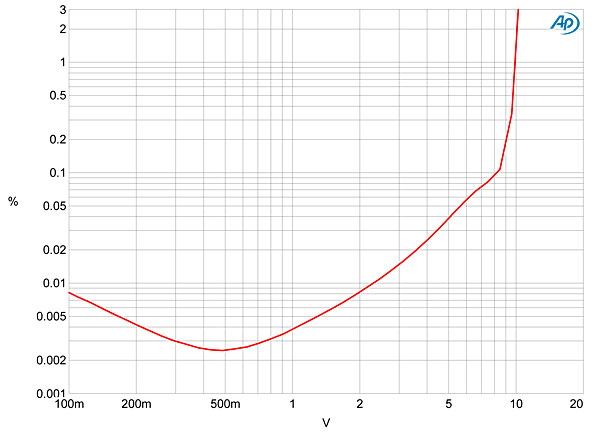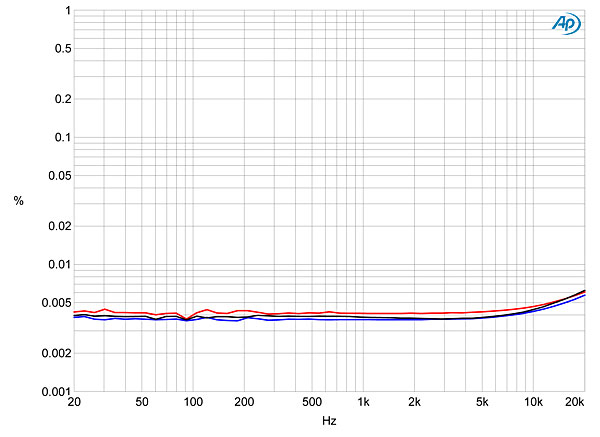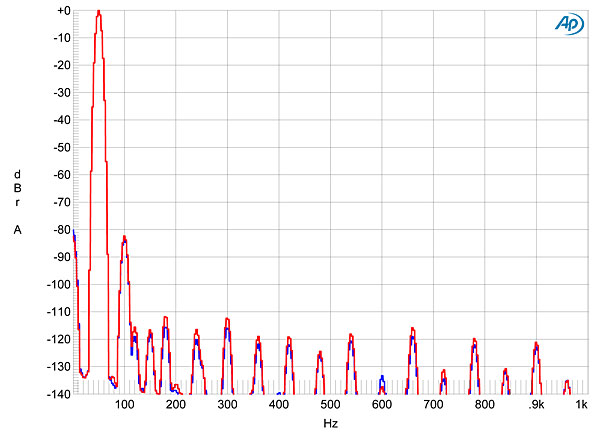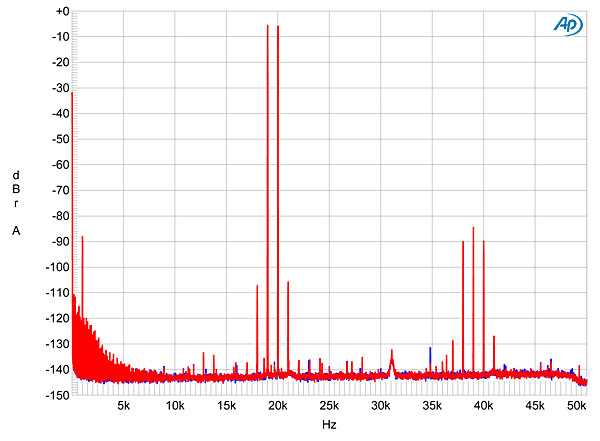| Columns Retired Columns & Blogs |
I just hate these glowing reviews from John Atkinson. It's costing me a small fortune.
I measured the Pass Labs HPA-1's electrical performance with my Audio Precision SYS2722 system (see the January 2008 "As We See It"). I performed a full set of measurements from both the HPA-1's preamplifier and headphone outputs. The graphs all refer to the headphone output; I comment when the preamplifier output behaved differently.
Both sets of outputs preserved absolute polarity (ie, were non-inverting), and the maximum gain was the same from both, at 8.35dB, this very close to the specified 8dB. The maximum output level at 1kHz was close to 10V. The input impedance measured a usefully high 46k ohms at 20Hz and 1kHz, dropping inconsequentially to 40k ohms at 20kHz. The output impedance from the headphone jack was a very low 1.35 ohms at all audio frequencies; it was higher from the preamplifier jacks but still low in absolute terms, ranging from 55 ohms in the low bass to 48 ohms at the top of the audioband.
The frequency responses of the HPA-1's two channels matched very closely but varied with the volume-control setting. The blue and red traces in fig.1 were taken from the headphone output with the volume control set to its maximum—the response is flat to the 200kHz limit of the graph. The green and gray traces were taken with the volume control set to 12:00—the output is now down by 3dB at 190kHz, but the audioband response is still perfectly flat. The response from the preamplifier outputs was also flat within the audioband, but down by 1dB at 200kHz with the volume control set to its maximum, and down by 3dB at 190kHz with it set to 12:00. The response from neither output was affected by the load impedance (fig.2).


Channel separation (fig.3) was superb, at close to 120dB in both directions at and below 1kHz, and still 95dB at the top of the audioband. The unweighted, wideband signal/noise ratio, measured at the headphone output jack with the inputs shorted to ground but with the volume control set to its maximum, was excellent, at 86.5dB ref. 1V. This improved to 98.5dB when the measurement bandwidth was restricted to the audioband, and to 102dB when A-weighted. The unweighted, wideband ratio was slightly greater from the preamplifier outputs, but otherwise similar to the ratios measured at the headphone jack.

Fig.4 plots how the percentage of THD+noise changes with output level into a low (30 ohm) load. The measurement is dominated by noise below 500mV, and although the actual distortion begins to emerge from the noise floor above that level, it remains below 0.01% up to 2V. The linear rise in THD+N with level above 2V suggests that only a moderate amount of loop negative feedback is used, and that actual waveform clipping occurs much higher in level. Into the low 30 ohm impedance, the HPA-1 clips (defined as when the THD+N reaches 1%) at 10V. The HPA-1 will have no problem driving even low-impedance headphones to unsociably high volumes. I measured how the THD+N percentage changed with frequency (fig.5) at a level, 1V, at which fig.3 had indicated that I would be looking at actual distortion. Even so, the level of distortion was very low, at around 0.004%, and the expected rise in THD at the top of the audioband was minimal.


The main distortion component was the second harmonic (fig.6), which is subjectively innocuous even when much higher in level than the –83dB (0.007%) at which it lies in this graph. Though some third harmonic is also present, this lies close to –120dB (0.0001%), and will therefore be irrelevant to sound quality. Similarly, though AC supply components can be seen at 120, 180, 240Hz, etc., unmasked by the very low level of random noise, these are all way too low to be anywhere close to audibility. Intermodulation distortion (fig.7) is also extremely low, with the 1kHz difference component resulting from an equal mix of 19 and 20kHz tones lying at –89dB (0.003%).


Pass Labs' HPA-1 offers superb measured performance that reflects equally superb audio engineering.—John Atkinson

I just hate these glowing reviews from John Atkinson. It's costing me a small fortune.

Mu-metal shielded toroidal transformer? Might want to double check with Jam on that. Mu-metal saturates at very low levels and wouldn't be very suitable for the sole shielding on a power transformer. Typically you'd use steel to reduce the levels to the point that you could use Mu-metal to handle the residual.

Nelson Pass has a rich history and remains (rightfully) a highly respected guy.
In no way do I feel his choice of (almost entirely?) Mosfet output stage devices (of his amplifiers)are the best choice. In fact far from it.
The amplifiers I (and many others) most enjoy are those utilizing premium bi-polar output (stage) devices.
Consider the splendid amplifiers from respected brands including including M-Levinson, Classe, Bryston, Spectral, SimAudio, Boulder M-Fidelity Luxman's amplifier/Int. amps (some or all?) and (I'll kick myself for forgetting names/brands) others employ this class of device. and for great reasons; the sheer speed/scale, clarity/definition, power/dynamics sounds refreshingly life-like. These qualities are near-immediately recognized in models utilizing this topology. And this, much before I decided to examine "why" in further detail -and come up with the association I now discuss.
Naturally, thre is far more to excellent amplifier design than choice of transistor. Yet, all of my favorite (and others of course) main power amplifiers ALL have this output stage device.
Anyway, I suspect the PASS HPA-1 HP amp also uses Mosfet devices. Yet ,this is not the reason for my reply.
The internal design/build of the HPA-1 reveals that it uses a simple volume pot (of unknown origin/quality. It also appears far more time/money was given to the large volume control/contrasting black chassis/volume styling cues as opposed to the far more important volume attenuation circuit/design employed.
The Sim Audio '430', on the oter hand (similarly priced) uses a far superior resistor/relay type set-up offering far superior performance than any "wiper-based" standard potentiometer.
At the prices of these items, we should all expect the finest parts commensurate with price.
And that would apply to all other products in the hi-fi world -or other worlds. Higher pricing is fine -just ensure the finest circuits/parts are used.
pj